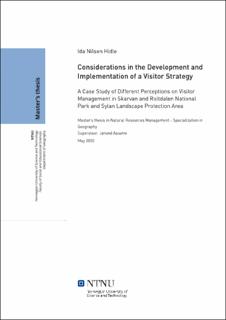| dc.contributor.advisor | Aasetre, Jørund | |
| dc.contributor.author | Hidle, Ida Nilsen | |
| dc.date.accessioned | 2021-09-28T17:54:38Z | |
| dc.date.available | 2021-09-28T17:54:38Z | |
| dc.date.issued | 2020 | |
| dc.identifier | no.ntnu:inspera:56115049:15871967 | |
| dc.identifier.uri | https://hdl.handle.net/11250/2785195 | |
| dc.description.abstract | Sammenhengen mellom bruk og naturvern er helt sentral i besøksforvaltning i verneområder. Selv om den norske naturen er attraktiv blant både innenlandske og utenlandske turister, har forvaltningen i liten grad fokusert på å promotere verneområdene. Med de nye merkevare- og besøksstrategiene tar derimot Miljødirektoratet sikte mot å legge til rette for flere besøkende i nasjonalparker og andre større verneområder, samtidig som verneverdiene beskyttes. Denne studien undersøker hvordan forskjellige lokale aktører og den lokal forvaltningsmyndigheten oppfatter besøksforvaltningen i Skarvan og Roltdalen nationalpark og Sylan landskapsvernområde i Trøndelag. Den ser spesielt på de ulike, og potensielt motstridende, målene i besøksforvaltningen og hvilke hensyn som bør prioriteres i utviklingen av en besøksstrategi. Studien har en kvalitativ tilnærming og funnene er hovedsakelig basert på intervjuer med åtte lokale og regionale informanter, i tillegg til en dokumentanalyse av the nye lokale besøksstrategien for disse områdene (The National Park Board for Skarvan and Roltdalen and Sylan, 2020). Dataene blir også sammenlignet med resultatene fra brukerundersøkelsen for dette området, som ble gjennomført av Selvaag et al. (2017). Studien utforsker hvordan besøk og turisme blir oppfattet likt og ulikt og hvilke interesser som blir sett på som viktigst i besøksforvaltningen. I diskusjonen blir disse perspektivene knyttet til teori om adaptive forvaltningstilnærminger og konseptene med Recreation Opportunity Spectrum (ROS) og Limits of Acceptable Change (LAC). Tilnærminene som uttrykkes av nasjonal og lokal forvaltning og av informantene blir også sett i sammenheng med rådende diskurser om naturvern.
Studien finner at mens det nasjonale målet for besøksforvaltning er å balansere tilrettelegging for besøksopplevelser, muligheter for lokal verdiskaping og naturvern, blir verneverdiene klart mest prioritert i den lokale forvaltningen. Videre er lokale aktører skeptiske til en økning i antallet besøkende. Flere informanter oppfatter målet om å legge til rette for flere besøkende i verneområder som motstridende og den nasjonale besøksforvaltningen som et paradoks. Den nye besøksstrategien i studieområdet fokuserer på kanaliseringstiltak, spesielt distribusjon av mer og bedre informasjon om den vernede naturen. Dette etterlyses også av mange informanter. Studien konkluderer med at synspunktene til de lokale informantene og nasjonalparkstyret generelt sett samsvarer med hverandre. De er skeptiske til vinn-vinn-tilnærmingen som ofte uttrykkes innen besøksforvaltningsfeltet. Videre fokuserer de for det meste på å begrense de negative virkningene av besøk or turisme. Dette kan være fordelaktig for et samarbeid mellom vernemyndighetene og den lokale turisnæringen. Det er likevel mulig at dette gjør besøksforvaltningen mer statisk og at man går glipp av de potensielle positive effektene av turisme. | |
| dc.description.abstract | The connection between use and nature conservation is central in visitor management in protected areas. Even though the Norwegian nature is attractive among both domestic and international tourists, the management has to little extent promoted the protected areas in particular. With the new brand and visitor strategies, however, the Norwegian Environment Agency is now aiming for more visitors in national parks and other large protected areas while at the same time ensuring the protection of conservation values. This study examines how different local stakeholders and the management authorities perceive visitor management in Skarvan and Roltdalen national park and Sylan landscape protection area in Trøndelag, Norway. It particularly looks at the different, and potentially conflicting, objectives of visitor management and which considerations should be emphasized in the development of a visitor strategy. The study has a qualitative approach and the findings are mainly based on interviews with eight local and regional informants as well as a document analysis of the new local visitor strategy (The National Park Board for Skarvan and Roltdalen and Sylan, 2020). The data is also compared to the findings from the user study for this area, which was conducted by Selvaag et al. (2017). The study explores how visitation and tourism are perceived similarly and differently and which interests are seen as most important in visitor management. In the discussion, these perspectives are linked to theory on adaptive management approaches and the concepts of Recreation Opportunity Spectrum (ROS) and Limits of Acceptable Change (LAC). The approaches expressed by national and local management and the informants are also connected to prevailing discourses on nature conservation.
The study finds that while the national goal of visitor management is to balance facilitation for visitor experiences, opportunities for strengthening local economies, and nature protection, the conservation values are highly prioritized in local management. Furthermore, the local stakeholders are skeptical of an increase in the number of visitors. Several informants perceive the aim of facilitating more people in protected areas as contradictory and the national visitor management as a paradox. The new visitor strategy in the study area is emphasizing measures with channeling effects, especially the distribution of more and better information about the protected nature. This is also called for by many informants. The study concludes that the perceptions of the local informants and the national park board generally correlate. They are skeptical of the win-win approach which is often expressed in visitor management. Further, they focus mostly on limiting the negative impacts of visitation. This may be beneficial in cooperation between the management authorities and the local tourism industry. However, it is possible that it makes the visitor management more static and that potential positive effects of tourism are missed out on. | |
| dc.language | | |
| dc.publisher | NTNU | |
| dc.title | Considerations in the development and implementation of a visitor strategy. A case study of different perceptions on visitor management in Skarvan and Roltdalen national park and Sylan landscape protection area | |
| dc.type | Master thesis | |
